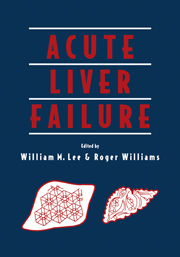Book contents
- Frontmatter
- Contents
- Preface
- Foreword
- Acknowledgments
- Contributors
- Part One Clinical Syndrome and Etiology
- 1 Classification and clinical syndromes of acute liver failure
- 2 Viral hepatitis and acute liver failure
- 3 Drug hepatoxicity as a cause of acute liver failure
- 4 Acetaminophen-induced acute liver failure
- 5 Unusual causes of acute liver failure
- 6 Pediatric aspects of acute liver failure
- Part Two Mechanisms of Disease and Multisystem Involvement
- Part Three Intensive Care Management
- Part Four Transplantation
- Part Five Artificial and Bioartificial Liver Devices
- Part Six Other Applications
- Index
- Plate section
6 - Pediatric aspects of acute liver failure
from Part One - Clinical Syndrome and Etiology
Published online by Cambridge University Press: 20 May 2010
- Frontmatter
- Contents
- Preface
- Foreword
- Acknowledgments
- Contributors
- Part One Clinical Syndrome and Etiology
- 1 Classification and clinical syndromes of acute liver failure
- 2 Viral hepatitis and acute liver failure
- 3 Drug hepatoxicity as a cause of acute liver failure
- 4 Acetaminophen-induced acute liver failure
- 5 Unusual causes of acute liver failure
- 6 Pediatric aspects of acute liver failure
- Part Two Mechanisms of Disease and Multisystem Involvement
- Part Three Intensive Care Management
- Part Four Transplantation
- Part Five Artificial and Bioartificial Liver Devices
- Part Six Other Applications
- Index
- Plate section
Summary
INTRODUCTION
The consequences of acute liver failure (ALF) have presented formidable challenges to both pediatricians and general physicians. Several important differences are observed in ALF when it occurs in different age groups. For example, hepatic encephalopathy is considered a cardinal component of the definition of ALF in adults, but in children encephalopathy need not be present to make the diagnosis of acute liver failure. Although ALF in children exhibits similarities to ALF in adults, there exist age-related differences in etiology and liver metabolism which demand an approach tailored specifically for the pediatric patient. The objective of this chapter is to discuss the unique aspects of ALF in children.
DEFINITION
The term acute liver failure is best employed to describe all forms of hepatic failure occurring de novo in a given time frame. The terms fulminant hepatic failure (FHF) and subacute and late-onset hepatic failure have been used to distinguish between clinical patterns of disease in adults (Trey and Davidson 1970). However, strict application of these definitions to ALF in children is problematic. In children, ALF is most often fulminant in nature (Sokol 1990; Balistreri 1994). Likewise, the lack of pre-existing liver disease is an essential part of the definition of FHF in adults, but in children, FHF is often the presenting feature of a chronic liver disorder (such as Wilson's disease or autoimmune hepatitis) which may have remained quiescent for months or years.
- Type
- Chapter
- Information
- Acute Liver Failure , pp. 53 - 66Publisher: Cambridge University PressPrint publication year: 1996



